A new paradigm for artificial intelligence and physics
With the launch of a new collaboration lab, physicists are adding fuel to the AI revolution, writes Perimeter Associate Faculty member Roger Melko.

Artificial intelligence is here to stay; we see it at work every time we use our smartphones or access our social networks. As we witness AI revolutionize our lives in real time, it is fair to wonder: How will physicists contribute to this new world? And how will this new paradigm of learning machines change our approach to physics?
Much of the groundbreaking work that drives AI research is done inside research labs like OpenAI, DeepMind, Berkeley Artificial Intelligence Research (BAIR), and many more. They are all known for their culture of innovation, and owe much of their success to strong industry-academic collaborations with Silicon Valley.
Tech giants offer top AI talent an enticing deal: high salaries, enviable levels of academic freedom, and the chance to be at the cutting edge of research. This pulls the direction of research, along with much of the talent, steadily towards industry. Yet we can reasonably wonder whether it is wise to concentrate so much of the world’s most promising scientific research talent inside of industry, on topics incentivized by commercial priorities, such as facial recognition or natural language processing.
How does all this relate to physics? As AI insiders already know, much of that top talent is coming from physics. Physicists populate the halls of AI research at every level of industry. With their toolbox of highly advanced mathematics and computer science, they’re a natural fit. Yet this is all happening as more and more physics sub-disciplines are adopting AI tools and strategies into their research. Demand for highly skilled computational physicists is growing in academia.
For me and some of my friends in quantum physics, this trend became clear about three years ago, after AI research made its first inroads into our field. We began to wonder, is there a way that physics, and physicists, could benefit from the same high-energy, competitive dynamic as other AI researchers?
To address this, last year Perimeter introduced the first AI lab formed directly out of a physics research institute. The Perimeter Institute Quantum Intelligence Lab, or PIQuIL (pronounced “pickle” for the uninitiated), was built by physicists, for physicists. Its goal is excellence in research and training at the intersection of quantum physics and machine learning: using AI to design the next generation of quantum materials and computers.
In the spirit of the flexible and innovative AI labs, PIQuIL residents cross the boundary between academic and industry research, while focusing on pure science. A unique ingredient is that, at PIQuIL, “industry” includes the fledgling world of quantum computing companies and startups.
PIQuIL researchers routinely work with real data from quantum computing laboratories. They are equally likely to be spotted among machine learning theorists and practitioners, from top institutions such as the Vector Institute for Artificial Intelligence. And alongside the cross-boundary research, a new generation of talented students, produced by our university undergraduate and graduate physics programs, is being trained on the very latest in artificial intelligence research.
PIQuIL is an exciting, evolving partnership between academia, government, and industry, with resident physicists from Perimeter Institute, the University of Waterloo, the National Research Council, and Canadian startup 1QBit. Residents work in the dynamic environment provided by Communitech, the Waterloo Region’s public-private innovation hub.
It turns out that this partnership produces a pretty eclectic mix of physicists. If you visit the lab, you’re equally likely to see students building a GPU rig, brainstorming pickle-themed swag, or arguing about decoherence models for a trapped ion quantum computer. When we’re not at our favourite Korean restaurant, we’re pushing GitHub commits for software with deadlines. But we still find time to write blogs about our favourite programming language or machine learning technique.
We hail from as far away as the US, Moldova, Cameroon, Ukraine, China… and as close as Waterloo, Kitchener, and Toronto. PIQuIL’ers intern in Silicon Valley, at private companies, and with quantum computing startups. But when at home, our ideas are disseminated freely and openly, online and in journals.
Our goal is to do hard science. But we hope that PIQuIL’s algorithmic discoveries will drive innovation in AI more broadly, both in industrial applications and in the foundational theories of the discipline. Alumni of our lab have already made their way into positions across academia and industry, spreading the seeds of these ideas across the global quantum-AI ecosystem. These physicists sense that the world is changing, and they want to be part of it.
Personally, I’m in it simply because I find it all so fascinating. Not just the way that AI science is changing so rapidly – that’s great. But it is also fascinating to see it change through the eyes of a dynamic young team of physicists, who are genuinely excited by what they work on. They know that they can change the world. Will they also change physics in the process?
– Roger Melko is a Perimeter associate faculty member and the Canada Research Chair in Computational Many-Body Physics





















































































